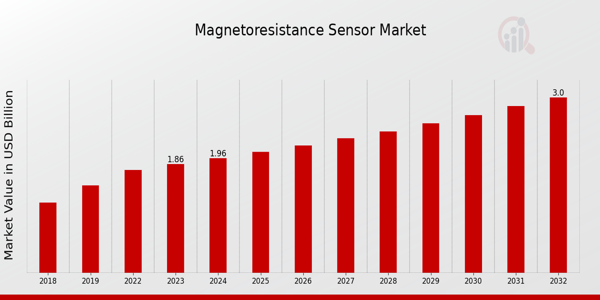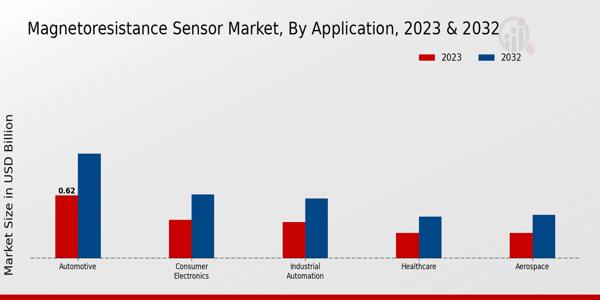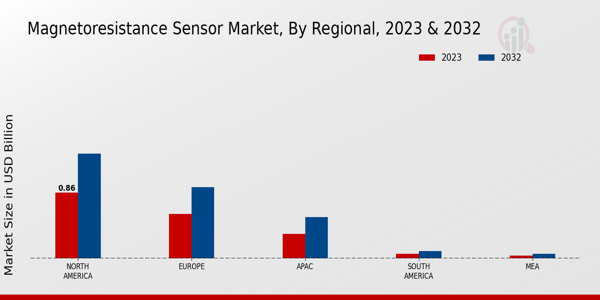Global Magnetoresistance Sensor Market Overview:
Magnetoresistance Sensor Market Size was estimated at 1.76 (USD Billion) in 2022. The Magnetoresistance Sensor Market Industry is expected to grow from 1.86(USD Billion) in 2023 to 3.0 (USD Billion) by 2032. The Magnetoresistance Sensor Market CAGR (growth rate) is expected to be around 5.48% during the forecast period (2024 - 2032).
Key Magnetoresistance Sensor Market Trends Highlighted
The Magnetoresistance Sensor Market is experiencing significant growth due to several key market drivers. Increasing demand for advanced sensing solutions in the automotive, consumer electronics, and healthcare industries is a primary factor stimulating market expansion. The rise of automation and smart technologies in various applications further accelerates the need for accurate and reliable sensors. Additionally, the trend toward miniaturization and the constant push for improved performance in electronic devices also contribute to the growing popularity of magnetoresistance sensors. These sensors offer enhanced advantages like low power consumption and high sensitivity, making them ideal for many sectors.
The Magnetoresistance Sensor Market has tremendous opportunities. The progress in industries towards automation and IoT-based applications has been increasing the need for complex sensors that can operate in intricate settings. New markets provide new channels for expansion as these markets have local manufacturers who are looking for advanced sensor technology. The focus of R&D on developing more sensitive and smaller-size sensors can bring about technologies that can fulfill the changing demands of customers. Moreover, the technology companies working together can also increase the market development and acquisition of these sensors for a wider range of the market.
Recent evolution tendencies have indicated a growing number of users of nanostructured materials that can heavily increase the performance of magnetoresistance sensors. More sensor systems integrating AI and machine learning also suggest that more advanced sensor technologies will be able to process more complex data and make better decisions in a variety of scenarios in the near future. Sustainability also becomes the focus, pushing the manufacturers to use greener materials and production processes. All in all, the Magnetoresistance Sensor Market will grow strongly given these key dynamics coupled with the changes in technology.

Source: Primary Research, Secondary Research, MRFR Database and Analyst Review
Magnetoresistance Sensor Market Drivers
Rising Demand for Consumer Electronics
The Magnetoresistance Sensor Market Industry is experiencing significant growth due to the rising demand for consumer electronics products. With the proliferation of smartphones, tablets, and wearable devices, there is an increasing need for advanced sensors that can improve functionalities such as motion detection, navigation, and enhanced user interfaces. Magnetoresistance sensors play a critical role in enabling these features by providing accurate magnetic field detection and measurement capabilities.As consumer electronics manufacturers strive to develop more sophisticated products that offer enhanced user experience and competitive advantages, the adoption of magnetoresistance sensors is expected to rise. This trend translates into substantial market growth opportunities for the Magnetoresistance Sensor Market Industry as manufacturers invest in research and development to integrate these sensors into their devices. Additionally, the miniaturization of electronic components encourages the integration of these sensors into compact designs, further driving demand.The growing trend of IoT (Internet of Things) devices also complements this driver, increasing the need for additional sensors to enable connectivity and data exchange. As the market evolves, innovative applications are expected to emerge, propelling the usage of magnetoresistance sensors across various segments of consumer electronics.
Advancements in Automotive Technologies
The Magnetoresistance Sensor Market Industry is being propelled by significant advancements in automotive technologies, particularly in the area of electric vehicles (EVs) and autonomous driving systems. The automotive sector has begun to recognize the importance of magnetoresistance sensors in various applications, including motor control, position sensing, and wheel speed detection. As the automotive industry shifts towards electrification and automation, these sensors provide the precision and reliability needed for critical applications.Additionally, the trend towards smart vehicles enables enhanced navigation systems and safety features, further integrating magnetoresistance sensors into modern automotive designs. As a result, manufacturers are investing heavily in the development of advanced magnetoresistance sensors tailored for automotive applications, which is expected to reflect in the growth of the Magnetoresistance Sensor Market Industry.
Growing Industrial Automation
The trend toward industrial automation is significantly boosting the Magnetoresistance Sensor Market Industry. Industries are increasingly adopting automation technologies to enhance productivity, reduce operational costs, and improve safety. Magnetoresistance sensors play a vital role in various industrial applications, such as position sensing, speed detection, and monitoring equipment health. By providing precise measurements in real-time, these sensors enable better control over manufacturing processes and machinery, leading to increased efficiency and reduced downtime.As industrial operations become more interconnected and data-driven, the demand for advanced sensors, including magnetoresistance types, is poised to grow. This surge in industrial automation initiatives not only supports market growth but also fosters innovation in sensor technology, paving the way for new applications and advancements in the Magnetoresistance Sensor Market.
Magnetoresistance Sensor Market Segment Insights:
Magnetoresistance Sensor Market Application Insights
The Magnetoresistance Sensor Market within the Application segment is poised for notable growth, reflecting the increasing demand for precise sensing technologies across multiple industries. In 2023, the market achieved a valuation of 1.86 USD Billion and is expected to rise significantly by 2032. Among the various applications, the automotive sector is a majority holding player, valued at 0.62 USD Billion in 2023 and projected to grow to 1.03 USD Billion by 2032. This segment's importance is driven by the rising integration of sensor technology in vehicles to enhance safety features and enable advanced driver-assistance systems (ADAS). Consumer electronics stands as another noteworthy application, valued at 0.38 USD Billion in 2023 and anticipated to grow to 0.63 USD Billion by the end of the forecast period. This growth can be attributed to the prevalent use of magnetoresistance sensors in smartphones and other personal devices, catering to the consumer's demand for compact yet effective technological solutions.
Industrial automation follows closely with a market valuation of 0.36 USD Billion in 2023, expected to expand to 0.59 USD Billion by 2032. The drive for automation and efficiency in manufacturing processes fundamentally boosts the demand for magnetic sensors capable of operating under various industrial conditions. Healthcare, although a smaller segment, is making its mark with a valuation of 0.25 USD Billion in 2023 and is projected to reach 0.41 USD Billion in 2032. The importance of magnetoresistance sensors in this domain lies in their application in medical devices and imaging technologies, which require high precision for effective diagnostics and patient monitoring.
Lastly, the aerospace segment, valued at 0.25 USD Billion in 2023 and growing to 0.43 USD Billion by 2032, showcases the evolving needs within the aviation industry for reliable sensor systems that can withstand extreme conditions while maintaining accuracy. In summary, the Magnetoresistance Sensor Market segmentation highlights diverse applications that collectively contribute to market growth, driven by technological advancements and the increasing reliance on sensor data across industries. These insights underline significant trends and opportunities that are shaping the future landscape of the sensor market.

Source: Primary Research, Secondary Research, MRFR Database and Analyst Review
Magnetoresistance Sensor Market Sensor Type Insights
The Magnetoresistance Sensor Market, valued at 1.86 billion USD in 2023, showcases a diverse array of sensor types that greatly contribute to its growth. Among these, Giant Magnetoresistance Sensors stand out due to their exceptional sensitivity and ability to detect minute magnetic fields, making them pivotal in applications such as data storage and read heads in hard drives. Tunnel Magnetoresistance Sensors also play a significant role, offering advantages in low power consumption and high-speed operations, which are essential for modern electronic devices and automotive applications.Lastly, Anisotropic Magnetoresistance Sensors dominate in orientation detection and position sensing, catering to industries like consumer electronics and automotive. The demand for advanced sensing capabilities drives the Magnetoresistance Sensor Market revenue, reflecting a trend towards smaller, more efficient designs and the growing importance of smart technology in various sectors. As the market continues to evolve, the combined capabilities of these sensor types present numerous opportunities for innovative applications across multiple industries, bolstering the market's growth trajectory.
Magnetoresistance Sensor Market End Use Industry Insights
The Magnetoresistance Sensor Market is set for remarkable growth as it caters to diverse end-use industries, reaching a valuation of 1.86 billion USD in 2023 and is projected to continue expanding effectively. Within the automotive industry, the integration of advanced sensors plays a crucial role in enhancing vehicle safety and performance as smart systems become increasingly necessary. In the electronics industry, these sensors are essential for applications such as data storage and imaging technologies, driven by the demand for miniaturization and improved efficiency.The manufacturing industry leverages magnetoresistance sensors to optimize processes and ensure precise measurements in automated systems, enhancing productivity and reducing costs. Meanwhile, the medical industry benefits from these sensors in various applications, including diagnostic devices and monitoring systems, emphasizing their importance in improving patient outcomes. Overall, the significance of the Magnetoresistance Sensor Market revenue across these sectors highlights an evolving market landscape where innovative technologies drive growth, demonstrating a steady increase in market demand and applications.As a result, the market growth in these segments showcases the substantial potential of advanced sensing technologies to adapt and thrive in today's industrial ecosystem.
Magnetoresistance Sensor Market Technology Insights
The Magnetoresistance Sensor Market, valued at 1.86 billion USD in 2023, showcases diverse applications driven by advancements in technology. The market encompasses various categories, including Analog Technology and Digital Technology, which play crucial roles in sector growth. Analog Technology is significant due to its prevalent use in various industrial applications, providing real-time data and reliable performance. Meanwhile, Digital Technology is gaining traction due to its ability to offer enhanced accuracy and integration with modern digital systems, which is becoming essential in automotive and consumer electronics.As the demand for precise sensing technologies continues to grow, these two technological approaches are expected to contribute significantly to the overall market dynamics. The Magnetoresistance Sensor Market data indicates that the evolution of applications across industries, coupled with increasing investments in R, will further enhance market growth. Trends such as IoT integration and miniaturization of devices continue to drive expansion in the Magnetoresistance Sensor Market industry, presenting substantial opportunities for innovation and development in both analog and digital domains.
Magnetoresistance Sensor Market Regional Insights
The Magnetoresistance Sensor Market is segmented regionally, showcasing varying growth dynamics and market valuations across different areas. In 2023, North America holds a dominant position, valued at 0.86 USD Billion, and is projected to expand to 1.37 USD Billion by 2032, reflecting its significant influence in the sensor industry. Europe follows with a valuation of 0.58 USD Billion in 2023, set to achieve 0.93 USD Billion in 2032, supported by advancements in automotive and consumer electronics sectors. The APAC region, valued at 0.32 USD Billion in 2023 and expected to reach 0.54 USD Billion by 2032, presents considerable growth potential due to the rising demand for smart devices and automation.South America and MEA, while smaller markets indicate growth from 0.06 USD Billion to 0.1 USD Billion and from 0.04 USD Billion to 0.06 USD Billion, respectively. The overall Magnetoresistance Sensor Market revenue reflects the increasing application of sensors in various industries, emphasizing the need for efficient technology adoption across these regions.

Source: Primary Research, Secondary Research, MRFR Database and Analyst Review
Magnetoresistance Sensor Market Key Players and Competitive Insights:
The Magnetoresistance Sensor Market has gained significant traction in recent years due to the increasing demand for advanced sensors in various applications, including automotive, consumer electronics, and industrial automation. Competitive insights reveal a diverse landscape characterized by innovative product developments, strategic partnerships, and growing investments in research and development. Players in this market are continually striving to improve performance characteristics, miniaturization, and integration capabilities of magnetoresistance sensors, which in turn enhance their functionality and applicability across multiple sectors. The competition is intensified by rapid technological advancements and evolving customer demands, prompting companies to adopt aggressive strategies to capture market share and strengthen their presence on a global scale.Mitsubishi Electric is a prominent player in the Magnetoresistance Sensor Market, leveraging its extensive expertise in manufacturing high-quality electronic components. The company has a well-established market presence backed by its robust research and development facilities, which enable innovative designs and applications of magnetoresistance sensors. Mitsubishi Electric's commitment to quality and reliability has positioned it favorably among various industrial clients, particularly in sectors needing precision sensing solutions. The company's emphasis on advanced technologies, such as integration with IoT devices and miniaturization of sensors, further enhances its competitive advantage, allowing it to meet the diverse needs of its customers. Additionally, Mitsubishi Electric has consistently focused on sustainability and eco-friendly solutions, aligning with the global trend toward environmentally conscious manufacturing practices.Microchip Technology is another significant entity in the Magnetoresistance Sensor Market, known for its versatile range of semiconductor products and solutions. Microchip's dedication to innovation has been instrumental in developing cutting-edge magnetoresistance sensors suitable for a variety of applications, including automotive systems and industrial control. The company's strong focus on customer-oriented solutions has led to the creation of highly adaptable sensor technologies that cater to specific use cases. Microchip Technology's comprehensive support services and resources facilitate ease of adoption and integration for its clients, further solidifying its standing in the market. Its commitment to continuous improvement and product excellence resonates well with industry trends, enabling Microchip to maintain a substantial presence and cater effectively to the evolving demands of the Magnetoresistance Sensor Market.
Key Companies in the Magnetoresistance Sensor Market Include:
-
Mitsubishi Electric
-
Microchip Technology
-
Bourns
-
NXP Semiconductors
-
Toshiba
-
Analog Devices
-
Honeywell
-
Emcore Corporation
-
Infineon Technologies
-
STMicroelectronics
-
Robert Bosch
-
Cypress Semiconductor
-
Adept Technology
-
Texas Instruments
Magnetoresistance Sensor Market Industry Developments
Recent developments in the Magnetoresistance Sensor Market have shown significant advancements as key players actively innovate and expand their technological portfolios. Companies such as Mitsubishi Electric and Honeywell have made strides in enhancing sensor performance for industrial applications, while Infineon Technologies and STMicroelectronics are focusing on integrating these sensors with IoT platforms to boost functionality. The market is also witnessing strategic mergers and acquisitions; notable activities involve Microchip Technology and Analog Devices, with reports of potential partnerships aimed at optimizing sensor developments, particularly in automotive and consumer electronics. Growth in market valuation has been stimulated by increasing demands for magnetic sensing solutions across various sectors, including automotive, healthcare, and industrial automation. Companies like Texas Instruments and Bourns are leveraging this upward trend to enhance their production capacities. Furthermore, global supply chain improvements have played an essential role, ensuring that companies like Robert Bosch and Cypress Semiconductor can meet the rising demand efficiently. Overall, the dynamics of the magnetoresistance sensor market are being shaped by technological innovations, strategic partnerships, and strong demand across diverse applications.
Magnetoresistance Sensor Market Segmentation Insights
-
Magnetoresistance Sensor Market Application Outlook
-
Automotive
-
Consumer Electronics
-
Industrial Automation
-
Healthcare
-
Aerospace
-
Magnetoresistance Sensor Market Sensor Type Outlook
-
Giant Magnetoresistance Sensor
-
Tunnel Magnetoresistance Sensor
-
Anisotropic Magnetoresistance Sensor
-
Magnetoresistance Sensor Market End Use Industry Outlook
-
Automotive Industry
-
Electronics Industry
-
Manufacturing Industry
-
Medical Industry
-
Magnetoresistance Sensor Market Technology Outlook
-
Analog Technology
-
Digital Technology
-
Magnetoresistance Sensor Market Regional Outlook
-
North America
-
Europe
-
South America
-
Asia Pacific
-
Middle East and Africa
|
Report Attribute/Metric
|
Details
|
|
Market Size 2022
|
1.76(USD Billion)
|
|
Market Size 2023
|
1.86(USD Billion)
|
|
Market Size 2032
|
3.0(USD Billion)
|
|
Compound Annual Growth Rate (CAGR)
|
5.48% (2024 - 2032)
|
|
Report Coverage
|
Revenue Forecast, Competitive Landscape, Growth Factors, and Trends
|
|
Base Year
|
2023
|
|
Market Forecast Period
|
2024 - 2032
|
|
Historical Data
|
2019 - 2023
|
|
Market Forecast Units
|
USD Billion
|
|
Key Companies Profiled
|
Mitsubishi Electric, Microchip Technology, Bourns, NXP Semiconductors, Toshiba, Analog Devices, Honeywell, Emcore Corporation, Infineon Technologies, STMicroelectronics, Robert Bosch, Cypress Semiconductor, Adept Technology, Texas Instruments
|
|
Segments Covered
|
Application, Sensor Type, End Use Industry, Technology, Regional
|
|
Key Market Opportunities
|
Rising demand in automotive applications, Growing adoption in consumer electronics, Expanding use in industrial automation, Innovations in healthcare devices, Increasing integration with IoT technologies
|
|
Key Market Dynamics
|
Technological advancements in sensors, Increasing demand for automation, Miniaturization of electronic devices, Growing automotive applications, Need for precise measurements
|
|
Countries Covered
|
North America, Europe, APAC, South America, MEA
|
Magnetoresistance Sensor Market Highlights:
Frequently Asked Questions (FAQ) :
The Global Magnetoresistance Sensor Market is expected to be valued at 3.0 USD Billion by 2032.
The market is projected to grow at a CAGR of 5.48% from 2024 to 2032.
North America is the largest region, valued at 0.86 USD Billion in 2023.
The Automotive application segment is expected to be valued at 1.03 USD Billion in 2032.
The Consumer Electronics segment is projected to reach a value of 0.63 USD Billion by 2032.
Key players include Mitsubishi Electric, Microchip Technology, and Honeywell, among others.
The Industrial Automation segment is valued at 0.36 USD Billion in 2023.
The Aerospace segment is anticipated to be valued at 0.43 USD Billion by 2032.
Europe is expected to reach a market size of 0.93 USD Billion by 2032.
The Healthcare segment is forecasted to reach a value of 0.41 USD Billion in 2032.


















